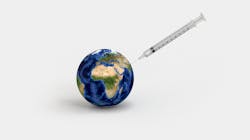An Estimated 92 percent of cancers caused by HPV could be prevented by vaccine
During 2012-2016, an average of 43,999 HPV-associated cancers were reported each year, according to a study published in Center for Disease Control and Prevention’s Morbidity and Mortality Weekly Report (MMWR). Among the estimated 34,800 cancers probably caused by HPV, 92 percent are attributable to the HPV types that are included in the HPV vaccine and could be prevented if HPV vaccine recommendations were followed, according to the report.
HPV is a common virus that can lead to certain types of cancers in men and women. It causes cancers of the cervix, vulva, vagina, penis, anus, and oropharynx (back of the throat, including the base of the tongue and tonsils). The HPV vaccine protects against the types of HPV that most commonly cause these cancers.
“A future without HPV cancers is within reach, but urgent action is needed to improve vaccine coverage rates,” said ADM Brett P. Giroir, MD, HHS Assistant Secretary for Health, in the announcement. “Increasing HPV vaccination coverage to 80 percent has been and will continue to be a priority initiative for HHS, and we will continue to work with our governmental and private sector partners to make this a reality.”
CDC researchers analyzed 2012-2016 data from the CDC’s National Program of Cancer Registries and the National Cancer Institute’s Surveillance, Epidemiology, and End Results (SEER) Programexternal icon to determine the incidence of HPV-associated cancers, and to estimate the annual number of cancers attributable to the HPV types in the currently available HPV vaccine. This report marks the first time these data are available at the state-level.
Key findings:
· During 2012-2016, an estimated average of 34,800 HPV-attributable cancers were diagnosed each year.
· The most common cancers were cervical (9,700) and oropharyngeal cancer (12,600).
· The number of cancers attributable to HPV types targeted by the vaccine ranged by state from 40 in Wyoming to 3,270 in California.
· Oropharyngeal cancer was the most common cancer attributable to the vaccine types in all states, except in Texas where cervical cancer was most mmon.
· In Alaska, the District of Columbia, New Mexico, and New York, the estimates of oropharyngeal and cervical cancers attributable to the types in the currently available HPV vaccine were the same.
CDC recommends that all preteens get the HPV vaccine when they are 11 or 12 years old to protect them before they are ever exposed to the virus. However, additional new data also released in the MMWR show little progress toward increasing HPV vaccination rates among teens ages 13- to 17-years. Overall, just 51 percent of all teens had received all recommended doses of the HPV vaccine, a 2-percentage point increase from 2017.
HPV vaccination rates were higher in teens whose parents reported receiving a recommendation from their child’s healthcare professional. Consistently, data shows that physicians play a key role in educating parents and are the most trusted source of information for parents of pre-teens eligible for vaccination. CDC and state health departments continue to encourage health care professionals to talk to parents and provide them with information on the benefits of vaccination to prevent cancer and save lives.
The HPV vaccine is recommended for everyone through age 26 if they did not get vaccinated when they were younger. Vaccination is not recommended for people older than 26 years. However, some adults ages 27 through 45 years who are not vaccinated for HPV may decide to be vaccinated after speaking with their doctor about their risk for new HPV infections and the possible benefits of vaccination. HPV vaccination in this age range provides less benefit, as more people have likely been exposed to HPV.
